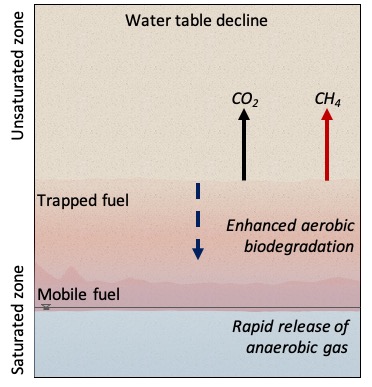Water table fluctuations impact the biodegradation of spilled fuels in soils

Cole J.C. Van De Ven, Keelin Scully, Mikaela Frame, Natasha J. Sihota, and K. Ulrich Mayer
As a result of the prevalence of fuels in our everyday lives, these fuels can be spilled or accidently released into the subsurface causing environmental and human health concerns. Fortunately, as a result of natural biodegradation in subsurface systems, these contaminants can be consumed and converted to less harmful by-products, carbon dioxide (CO2) and methane (CH4). Utilizing this biodegradation is a viable remedial approach called natural source zone depletion (NSZD). To determine the effectiveness of NSZD, a non-invasive method of measuring the surface efflux of CO2 and CH4 has been developed. However, this study looked to better quantify this biodegradation in dynamic subsurface systems resulting from water table fluctuations, which are expected in natural systems. Using a unique experimental sand tank, measuring 4 m long, 1 m wide and 1.5 m tall, a fuel spill was simulated then we induced water table fluctuations and measured the resulting changes in effluxes and biodegradation. Results show that lowering the water table led to both short-term, large increases in effluxes and long-term increases in biodegradation. This research advances our knowledge of dynamic subsurface effects on NSZD and allows us to better monitor and assess the remediation of contaminated groundwater systems.

On decline, mobile fuel moves downward with the water table, allowing for the rapid release of anaerobically produced gas from below the water table and enhanced aerobic degradation of the more exposed, trapped fuel above the water table.